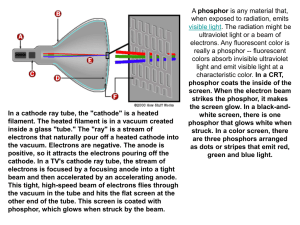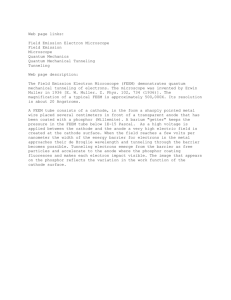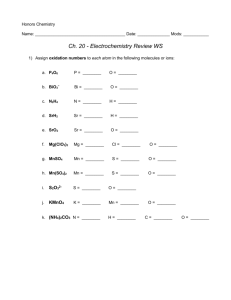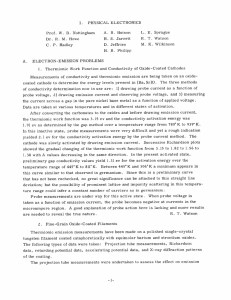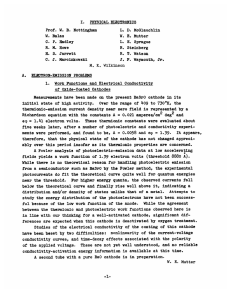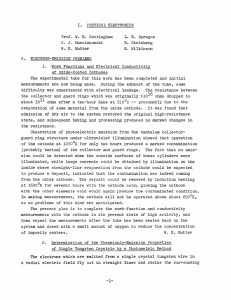I. PHYSICAL ELECTRONICS Prof. W.B.Nottingham L.E.Sprague
advertisement
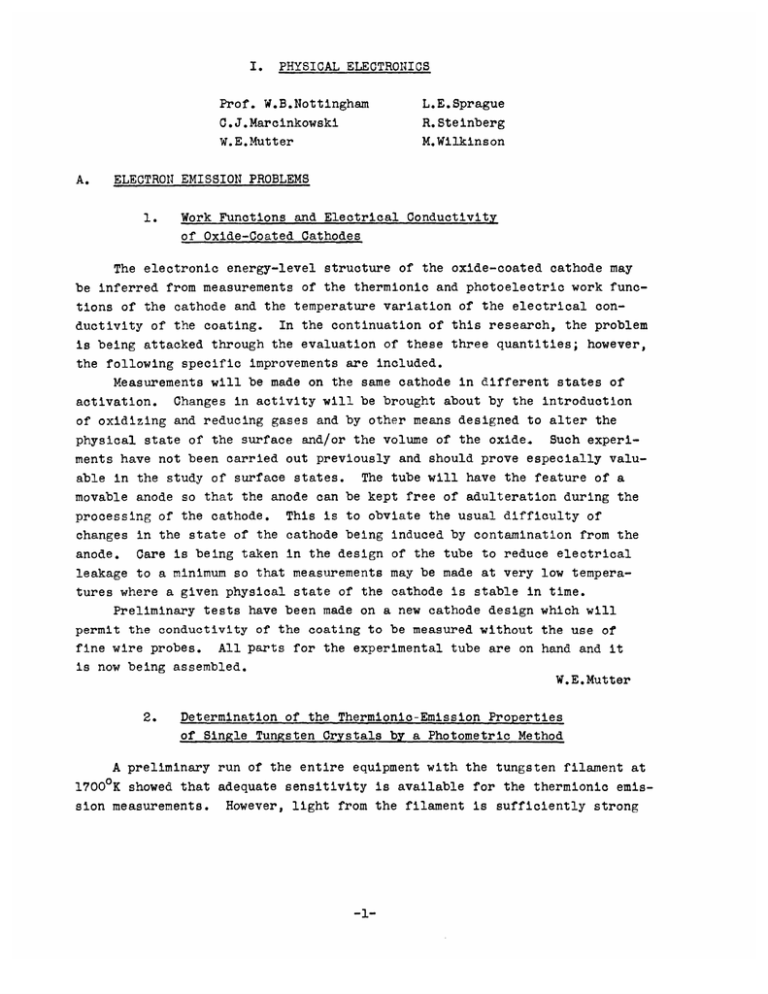
I. A. PHYSICAL ELECTRONICS Prof. W.B.Nottingham L.E.Sprague C.J.Marcinkowski W.E.Mutter R.Steinberg M.Wilkinson ELECTRON EMISSION PROBLEMS 1. Work Functions and Electrical Conductivity of Oxide-Coated Cathodes The electronic energy-level structure of the oxide-coated cathode may be inferred from measurements of the thermionic and photoelectric work functions of the cathode and the temperature variation of the electrical conductivity of the coating. In the continuation of this research, the problem is being attacked through the evaluation of these three quantities; however, the following specific improvements are included. Measurements will be made on the same cathode in different states of Changes in activity will be brought about by the introduction of oxidizing and reducing gases and by other means designed to alter the physical state of the surface and/or the volume of the oxide. Such experiactivation. ments have not been carried out previously and should prove especially valuable in the study of surface states. The tube will have the feature of a movable anode so that the anode can be kept free of adulteration during the processing of the cathode. This is to obviate the usual difficulty of changes in the state of the cathode being induced by contamination from the anode. Care is being taken in the design of the tube to reduce electrical leakage to a minimum so that measurements may be made at very low temperatures where a given physical state of the cathode is stable in time. Preliminary tests have been made on a new cathode design which will permit the conductivity of the coating to be measured without the use of fine wire probes. All parts for the experimental tube are on hand and it is now being assembled. W.E.Mutter 2. Determination of the Thermionio-Emission Properties of Single Tungsten Crystals by a Photometric Method A preliminary run of the entire equipment with the tungsten filament at 17000K showed that adequate sensitivity is available for the thermionic emission measurements. However, light from the filament is sufficiently strong -1- 1~_1 i~ (I. PHYSICAL ELECTRONICS) to constitute an appreciable fraction of the phosphor luminescence which it is desired to measure. In the first measurements, the undesired light will be eliminated by a subtraction technique. Improvements are being made in the optical system to minimize the amount of correction necessary, as well as to reduce the general background luminescence due to scattering. C.J.Marcinkowski 3. Determination of the Field-Emission Properties of Single Tungsten Crystals by a Photometric Method This study has the purpose of obtaining quantitative data on the field emission from a single crystal of tungsten as a function of crystallographic direction and electric field at the surface. It is planned to use a spherical tube, the glass envelope of which will be coated with a phosphor. The filament will be a single crystal of tungsten in the form of an extremely sharp point, etched either chemically or electrolytically from three-mil tungsten wire. Application of the high voltage and collection of the secondary electrons emitted from the phosphor will be accomplished by a circular anode of tantalum wire surrounding the point filament. The emission current will be measured by photometry of the phosphor bombarded by the field emission electrons, a method now being used by C.J.Marcinkowski for the measurement of thermionic emission. This type of measurement allows a study of the emission as a function of crystallographic direction, and is a very important feature in checking the theoretical equations. Work is now progressing toward the development of experimental etching techniques which will consistently give points suitable for use as sources in these field-emission studies. M.K.Wilkinson B. STUDIES WITH GASEOUS DISCHARGES 1. Hot Cathode Arc in Cesium Vapor Work has been started on the construction of a tube for the study of arcs in cesium vapor by means of probes. In particular, it is planned to obtain information concerning potential distribution along the axis of the arc, but measurements on such properties as electron and positive-ion random currents, electron temperature, and electron velocity distribution are also contemplated. -2- (I. PHYSICAL ELECTRONICS) The tube is to contain a plane thermionic cathode and a plane anode mounted on a quartz and glass assembly which can be moved along the axis of the tube by tilting it. Two probes, one a small plane probe and the other a hot-wire probe, are to be mounted in the side of the tube at the same point along its axis. Measurements will be made with the plane probe using the usual Langmuir technique. The hot-wire probe is to be used principally in the determination of plasma potential, this determination to be made by two methods. The first method, originally described by Langmuir, is to note the minimum potential at which the current to the probe is the same, whether it is heated to a temperature at which it is capable of appreciable thermionic emission or whether it is cold. The other method involves the measurement of probe floating potential as a function of its temperature. It is expected that the floating potential will rise with temperature to approximately plasma potential when the thermionic emission from the probe equals the random electron current arriving at the probe from the plasma; but it will not rise more than one or two tenths of a volt above plasma potential at higher temperatures. This result is expected because the initial veloc- ities of the electrons leaving the probe are small enough so that only a small potential "hill" should be sufficient to reduce the thermionic emission to random electron current of the plasma, which is the condition for floating potential. The work function of a surface in cesium vapor is strongly dependent on temperature due to the varying fraction of a cesium monolayer which appears on the surface. To correct for the error which would be caused in potential measurements by this effect, the anode (to which potentials will be referred) is to be constructed so that it can be heated and maintained at the same temperature as the probe. The cathode and anode with their heaters, the hot-wire probe, the movable assembly and the glass envelope have been constructed. The cathode and anode are being rebuilt, however, principally because the original ones were found to be too fragile. R.K.Steinberg C. EXPERIMENTAL TECHNIQUES 1. Spectral Emissivity of Tungsten During the past quarterly period, additional developments have been undertaken to improve the accuracy of the final results. A new specimen -3- I_^ rpl~~____ I_--L -~-l~LLI (I. PHYSICAL ELECTRONICS) for the tungsten study has been produced with the cooperation of the Research Laboratory of the General Electric Company at Schenectady. This specimen has not yet been mounted. The program calls for obtaining preliminary results with the new tube during the next quarter. Prof. W.B.Nottingham, W.E.Mutter, L.E.Sprague 2. Ionization Gauge and High-Vacuum Studies The work on this study has been temporarily discontinued, but the project will be reinstated on the active list as soon as possible. Prof. W.B.Nottingham, L.E.Sprague 3. Survey of Methods Used to Determine the Optical Properties of Phosphors During the active period of the M.I.T. Radiation Laboratory, a staff group made special studies of the photometric properties of phosphors. Although some work has been done in this field at RLE, it is inactive at present. Studies are being carried on in a number of other laboratories and this present survey study is being conducted to cbrrelate the activities in this field. A report on this survey study will be made available as soon as the investigation has been completed. Prof. W.B.Nottingham -4-


